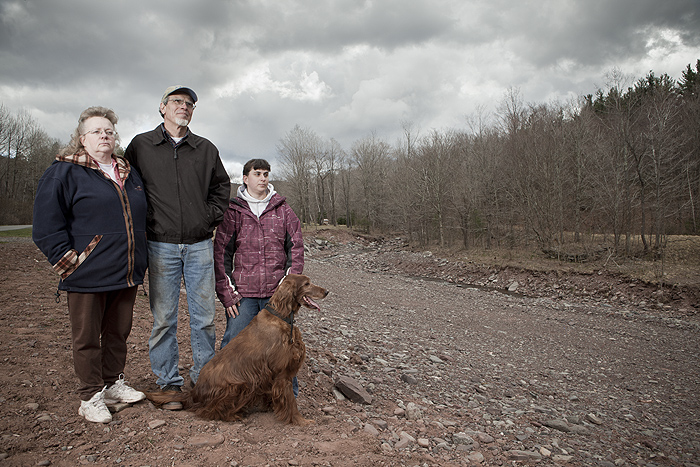Bill Lonecke
Retired history teacher
Maplecrest, Greene County
Bill Lonecke with his wife, Barbara (left), and daughter, Cindy (right), standing where their house used to be. It was washed away by the Batavia Kill, which is 50 yards away to the right. Photo by Christopher Auger-Domínguez.
For 25 years, Bill Lonecke knew that the Batavia Kill would take his house someday.
Lonecke’s land hugs the curving bank of a sharp swerve in the stream. In 1986, during a flood, the stream changed course and washed part of his backyard away. Afterwards, a New York State Department of Environmental Conservation officer came to assess the damage.
To Lonecke, the solution was simple. “I said, 'All I need you guys to let me do is get in there with a machine and put the stream back,'” Lonecke said.
Not allowed, said the DEC man.
Lonecke remembered: “The man said to me: 'Our policy is to let the stream find its natural course.’” I said, ‘Even if that means its natural course is through my living room?’ He didn’t say anything; just turned around and got in his truck.”
Twenty-five years later, the Batavia Kill finished eroding the bank under Lonecke’s house. It was around noon on Sunday, August 28: Lonecke and his wife and daughter watched from the safety of their cars as the whole house slipped the bank and disintegrated downstream.
Lonecke’s water heater is in the streambed. Someone propped it up so that you can see it from the road. He drives by it every day.
“It used to really depress me as I walked down the stream and picked up little pieces of what used to be my life,” Lonecke said. “Now I’m just angry. It should never have happened.”
Interview with Bill Lonecke
Watershed Post: When did you begin getting angry?
Bill Lonecke: Probably right after Christmas, when I realized that nothing was being done to prevent this from happening in the future. That’s when I began to get mad. At C.D. Lane Park [up the street from Lonecke's house], there is anywhere from 30 to 60 inches of sediment that has settled on the bottom of the lake bed. I believe they have no plans to clean it up. I do know that if you have a 5-gallon bucket and you fill half of it with sand, you can't get five gallons into it again.
WP: Are people listening to you?
BL: Yeah, but not the right people. It seems to me that whenever I bring these things up to people who should be able to have some authority to makes changes, I get the feeling I’m like a little kid and I get patted on the head. I get the feeling in some cases [that they're thinking]: "It’s your fault for building a house there."
Weather patterns are changing … The flood control dams here in Windham were built to withstand a 100-year-flood, of which I’ve lived through four. I'm 57 years old.
This is now the 21st century, and eight inches of rain is [just] a heavy storm here. Now a flood is anywhere from 12 to 16 inches. So when I ask -- and I have -- what plans do we have to update all of these things, you’d think I’m sitting there screaming obscenities at people.
I’m real tired of hearing "I’m sorry, we can’t do this because we don’t have any money," or "That's not practical." I'm not an engineer, but I’m intelligent enough, and most people are intelligent enough, to get it.
WP: How do you think people who lost homes and land in the flood feel a year later?
BL: I think people are frightened. I think people are angry. And I know people are frustrated. And I think the whole thing is communication. There appears to be a huge disconnect between the people who have been affected by this and the people who have some authority to fix it. Like when the Department of Environmental Conservation says: "Our policy is to let the stream find its natural course," and then it ignores you when you ask, "What about my house?" At the very least, the guy could have said something. I got nothing from the guy. He turned around as if I had insulted his entire family.













